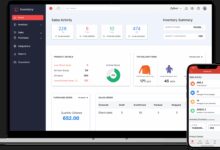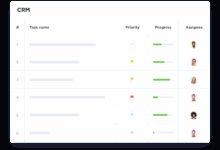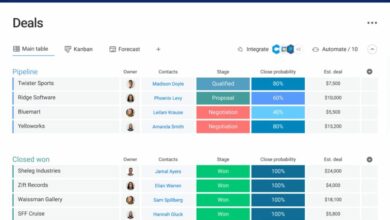CRM Migration Services: 7 Powerful Steps to Seamless Transition
Switching CRM platforms doesn’t have to be a nightmare. With the right CRM migration services, businesses can transfer data smoothly, boost efficiency, and unlock powerful new features—without losing a beat.
What Are CRM Migration Services?

CRM migration services refer to the professional support and technical processes involved in transferring customer data, workflows, configurations, and integrations from one Customer Relationship Management (CRM) system to another. This transition is often necessary when a business outgrows its current platform, seeks better automation, or wants to unify operations across departments.
Defining CRM Migration
At its core, CRM migration is not just about moving data—it’s about preserving the integrity, structure, and usability of customer information while aligning it with a new system’s architecture. This process includes extracting data from the legacy CRM, cleaning and transforming it, and loading it into the new environment—a process often referred to as ETL (Extract, Transform, Load).
- Data extraction from source systems
- Transformation to match new CRM schema
- Secure loading into the target CRM platform
Why Businesses Need Professional CRM Migration Services
While some companies attempt in-house migrations, the complexity of data mapping, user permissions, and integration dependencies often leads to errors, downtime, or data loss. Professional CRM migration services provide expertise, tools, and project management to ensure a smooth transition. According to Gartner, organizations using third-party migration specialists report 40% fewer post-migration issues.
“A successful CRM migration isn’t measured by speed—it’s measured by accuracy, completeness, and user adoption.” — CRM Industry Expert
Top Reasons Companies Migrate Their CRM Systems
Businesses don’t migrate their CRM systems on a whim. The decision is usually driven by strategic goals, technological limitations, or evolving customer demands. Understanding these motivations helps organizations plan better and choose the right CRM migration services.
Outgrowing Legacy Systems
Many companies start with basic CRMs like ACT! or Microsoft Dynamics GP, but as they scale, these platforms lack advanced analytics, automation, or mobile access. Migrating to modern platforms like Salesforce, HubSpot, or Microsoft Dynamics 365 becomes essential for growth.
- Limited customization options
- Poor integration with marketing or sales tools
- High maintenance costs
Demand for Better Integration and Automation
Today’s sales and marketing teams rely on seamless integration between CRM, email, social media, and customer support tools. Legacy systems often can’t support APIs or real-time sync, leading to data silos. CRM migration services help integrate platforms like Zapier, Mailchimp, or Slack into the new CRM ecosystem.
Improving User Experience and Adoption
If employees avoid using the CRM due to clunky interfaces or slow performance, the system fails its purpose. Modern CRMs offer intuitive dashboards, AI-driven insights, and mobile accessibility. A well-executed migration improves user adoption, which directly impacts sales productivity.
Key Challenges in CRM Migration
Despite the benefits, CRM migration is fraught with risks. Without proper planning and CRM migration services, companies face data corruption, workflow disruption, and extended downtime.
Data Quality and Consistency Issues
One of the biggest hurdles is inconsistent or incomplete data. Duplicate records, missing fields, or outdated contact information can derail migration. Data cleansing must occur before migration. Tools like Informatica and Talend are often used by CRM migration services to standardize and validate data.
Complex Data Mapping and Schema Alignment
Each CRM has its own data model. For example, Salesforce uses Objects and Fields, while HubSpot uses Properties and Modules. Mapping fields correctly—such as aligning “Lead Status” in the old system with “Lifecycle Stage” in the new one—requires deep technical knowledge. CRM migration services use schema analysis tools to automate and verify these mappings.
Minimizing Downtime and Business Disruption
Businesses can’t afford days of downtime. A phased migration approach, where data is moved in batches during off-peak hours, is often recommended. CRM migration services employ rollback plans and real-time monitoring to ensure continuity.
“Over 60% of CRM migration failures are due to poor data mapping and lack of testing.” — TechTarget CRM Report
7 Powerful Steps in CRM Migration Services
A successful CRM migration follows a structured, step-by-step process. Leading CRM migration services use this 7-phase framework to ensure reliability and scalability.
1. Assessment and Planning
This initial phase involves auditing the current CRM, identifying key data entities (contacts, accounts, deals), and defining migration goals. Stakeholders from sales, marketing, and IT collaborate to set priorities. A detailed project timeline, resource allocation, and risk assessment are created.
- Inventory of existing data fields and customizations
- Define success metrics (e.g., 99.9% data accuracy)
- Select migration team and tools
2. Data Audit and Cleansing
Before migration, data must be cleaned. This includes removing duplicates, standardizing formats (e.g., phone numbers, addresses), and archiving inactive records. CRM migration services use automated scripts and AI-powered tools to accelerate this process.
3. Schema Design and Field Mapping
Design the data structure in the new CRM. Map source fields to target fields, ensuring logical alignment. For example, map “Opportunity Stage” to “Deal Stage” and convert picklist values appropriately. Tools like Jitterbit or MuleSoft assist in visual mapping.
4. Test Migration (Dry Run)
Perform a small-scale test migration with a subset of data. Validate accuracy, check for broken links, and verify integrations. This phase often uncovers hidden issues like API rate limits or field truncation.
5. Full Data Migration
Once testing is successful, execute the full migration. This is typically done during weekends or low-activity periods. CRM migration services use secure, encrypted channels to transfer data and monitor the process in real time.
6. Validation and Quality Assurance
After migration, conduct thorough validation. Compare record counts, spot-check data accuracy, and ensure workflows function correctly. Automated scripts can verify thousands of records in minutes.
7. Training and Go-Live Support
User adoption is critical. CRM migration services provide training sessions, user guides, and post-go-live support. They also monitor system performance and address issues promptly.
Choosing the Right CRM Migration Services Provider
Not all CRM migration services are created equal. The right provider can make the difference between a smooth transition and a costly disaster.
Experience and Certifications
Look for providers with proven experience in your industry and CRM platform. Certifications from Salesforce, Microsoft, or HubSpot indicate technical proficiency. For example, a Salesforce-certified architect understands security models, sharing rules, and automation logic.
Comprehensive Service Offerings
The best CRM migration services offer end-to-end support: planning, data cleansing, migration, testing, training, and post-migration optimization. Avoid vendors that only handle data transfer without strategic consulting.
Client Testimonials and Case Studies
Review case studies to see how the provider handled similar migrations. Did they reduce migration time? Improve data quality? Increase user adoption? Real-world examples provide insight into their capabilities.
Top CRM Platforms Requiring Migration Services
Different CRM platforms have unique migration requirements. Understanding these helps in selecting the right CRM migration services.
Salesforce to Salesforce (Org-to-Org Migration)
Even within the same platform, migrating between Salesforce orgs (e.g., from a sandbox to production or merging two orgs) requires careful planning. CRM migration services use tools like Salesforce Data Loader, Workbench, or third-party apps like Gearset and Copado.
- Preserve custom objects and Apex triggers
- Maintain user roles and sharing settings
- Handle large data volumes efficiently
Migrating from On-Premise to Cloud CRM
Companies moving from on-premise systems like Siebel or Microsoft Dynamics CRM 2016 to cloud-based solutions face challenges in data security, network latency, and compliance. CRM migration services ensure secure data transfer and compliance with GDPR, HIPAA, or CCPA.
HubSpot, Zoho, and Microsoft Dynamics Migrations
Each platform has its nuances. HubSpot migrations often focus on marketing automation and lifecycle stages. Zoho migrations may involve multi-module transfers (CRM, Books, Campaigns). Microsoft Dynamics migrations require integration with Office 365 and Power Platform. CRM migration services tailor their approach to each ecosystem.
Cost of CRM Migration Services
The cost varies widely based on data volume, complexity, and provider expertise. Understanding pricing models helps businesses budget effectively.
Factors Influencing Migration Costs
Key cost drivers include:
- Number of records to migrate (1,000 vs. 1 million)
- Number of custom fields and workflows
- Integration with third-party apps
- Need for data cleansing and deduplication
Pricing Models: Fixed Fee vs. Hourly Rate
Some CRM migration services charge a fixed fee for end-to-end projects, while others bill hourly. Fixed fees offer predictability, while hourly rates may be better for complex, evolving projects. Average costs range from $5,000 for small migrations to over $100,000 for enterprise-level transitions.
Hidden Costs to Watch For
Be aware of additional expenses like:
- Post-migration support
- Training sessions
- License upgrades for the new CRM
- Third-party tool subscriptions
Best Practices for a Successful CRM Migration
Following industry best practices increases the likelihood of a seamless transition and long-term success.
Start with a Clear Migration Strategy
Define objectives: Are you migrating for scalability, better reporting, or improved user experience? A clear strategy guides every decision, from tool selection to timeline.
Involve Stakeholders Early
Engage sales, marketing, customer service, and IT teams from the start. Their input ensures the new CRM meets real-world needs and reduces resistance to change.
Backup Data Before Migration
Always create a full backup of the existing CRM. This provides a safety net in case of errors. CRM migration services typically automate this step using secure cloud storage.
Test, Test, and Test Again
Multiple test migrations with different data sets help identify edge cases. Test not just data accuracy, but also reporting, automation, and mobile access.
“The best CRM migration is invisible to end-users—data is accurate, systems are fast, and workflows just work.” — CRM Consultant
Future Trends in CRM Migration Services
The landscape of CRM migration is evolving with AI, automation, and cloud-native architectures.
AI-Powered Data Mapping and Cleansing
AI tools can now automatically suggest field mappings, detect duplicates, and enrich missing data. Platforms like IBM Watson and Microsoft Azure AI are being integrated into CRM migration services for smarter, faster processing.
Zero-Downtime Migration Solutions
Emerging technologies enable live data synchronization between old and new systems during migration. This allows businesses to switch seamlessly without interrupting operations.
Increased Focus on Data Privacy and Compliance
With stricter data protection laws, CRM migration services must ensure compliance during data transfer. Encryption, anonymization, and audit trails are becoming standard.
What are CRM migration services?
CRM migration services are professional solutions that help businesses transfer data, configurations, and integrations from one CRM system to another, ensuring data integrity, minimal downtime, and user adoption.
How long does a CRM migration take?
Timeline varies: small migrations may take 2–4 weeks, while enterprise projects can last 3–6 months, depending on data volume, complexity, and testing requirements.
Can I migrate CRM data myself?
While possible for small datasets, DIY migrations risk data loss and errors. Professional CRM migration services reduce risk and ensure a smooth transition with expert support.
What data should be migrated?
Essential data includes contacts, accounts, leads, opportunities, activities, emails, and custom fields. Non-essential or outdated data should be archived or excluded.
How do I choose the right CRM migration provider?
Look for platform-specific expertise, certifications, client testimonials, and end-to-end service offerings. Request case studies and ask about their testing and support processes.
Migrating your CRM is a pivotal step toward digital transformation. With the right CRM migration services, businesses can unlock greater efficiency, improve customer insights, and drive growth. From assessing needs to post-go-live support, a structured approach ensures success. By understanding challenges, following best practices, and leveraging expert providers, companies can make the transition seamless and impactful. The future of CRM migration is faster, smarter, and more secure—powered by AI and cloud innovation.
Further Reading:






